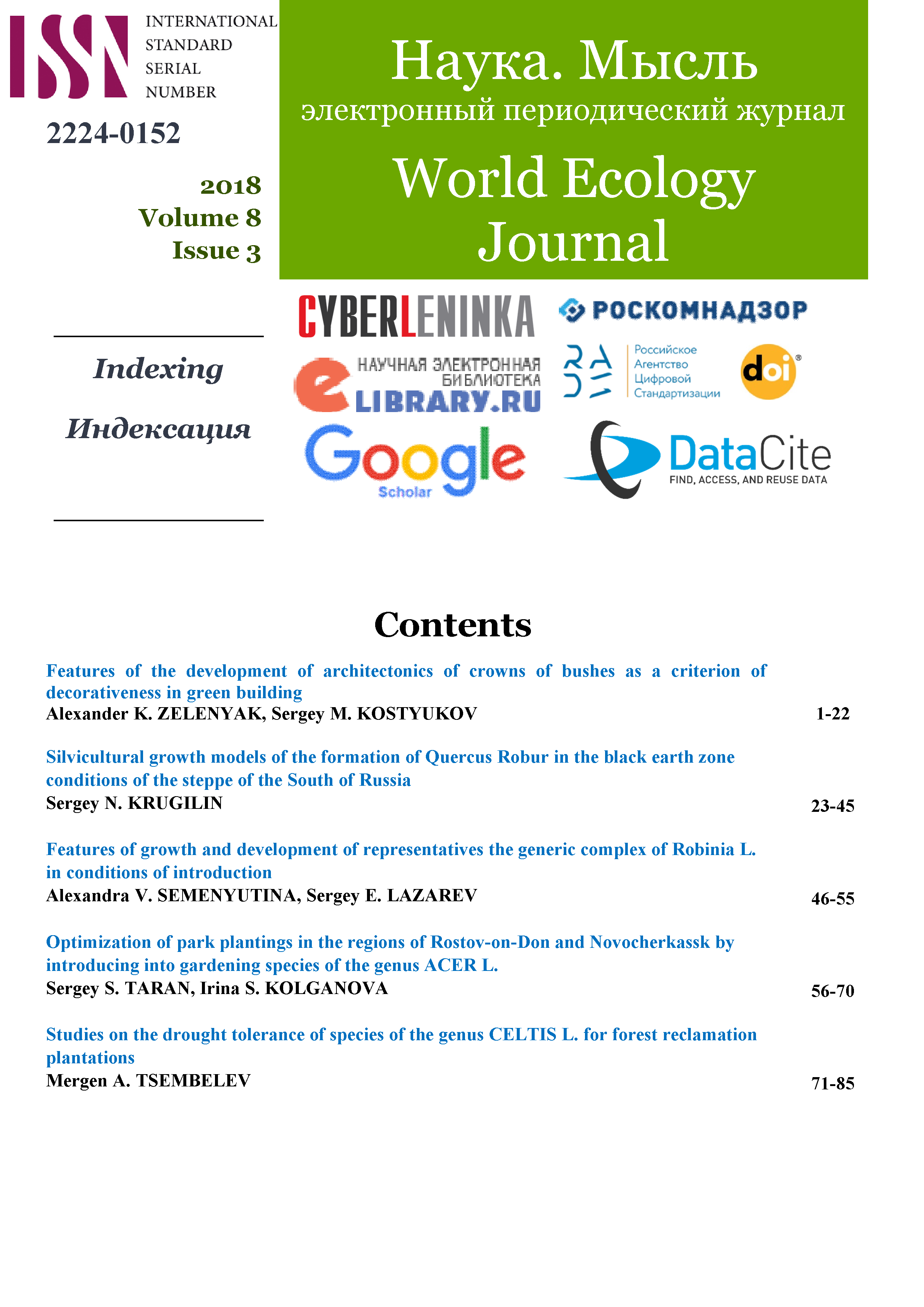Silvicultural growth models of the formation of Quercus Robur in the black earth zone conditions of the steppe of the South of Russia
DOI:
https://doi.org/10.25726/NM.2019.49.29.002Keywords:
Growth of pedunculate oak, programmed growing of forest cultures, rhythm of growth of the main and auxiliary species, type of mixing, formation of plantations.Abstract
Within the territory of the European part of Russia, the steppe zone covers more than 60 million hectares. The steppes are represented in the Southern Urals, on the Volga, on the Don, in Ciscaucasia, in the Trans-Volga region. Growing up steppe plantings, specialists always face big problems, primarily related to natural conditions. It is natural conditions that cause special approaches in the design, creation and cultivation of forest crops.
One of the main tree species in the black earth zone of the South of Russia is pedunculate oak. During the cultivation of oak culture, many minor issues arise concerning the selection of accompanying breeds, schemes of mixing and placement, density in different age periods.
In other words, an important point in the formation of artificial stands of pedunculate oak is information about silvicultural models. After all, it is the knowledge of the model of behavior of plantations in different age periods that will allow to grow productive and sustainable plantations that will fully perform the assigned function in our steppe zone - protective!
The aim of the present work is to analyze the course of growth of pedunculate oak mixed with different tree and shrub species and to develop their silvicultural models for the conditions of the black earth zone of southern Russia.
References
2. Zhezhkun A.M. Dubovі tree staniskhіdnogo polіssya: formavannya, camp, productiveness Науковий вісник НУБіП України. Seriya: Lіs_vnittvot more decorative gardening. 2013.№187-2. Pp. 49-58.
3. Kruzhilin S., Baranova T. Principles of modern approaches to forest vegetation zoning, forest types and growing conditions World Ecology Journal. 2017. No. 7 (7). Pp. 29-34. URL: https://doi.org/https://doi.org/10.25726/nmenzh.v7i7.6
4. Kruzhilin S., Ishchenko O., Bagdasaryan A. Monitoring of oak forests in the conditions of the Lower Don (on the example of Donleskhoz) World Ecology Journal. 2017. No. 7 (7). Pp. 35-39. URL: https://doi.org/https://doi.org/10.25726/nmenzh.v7i7.7
5. Kruzhilin S.N. Cultivation of pedunculate Oak trees using the rocker method of mixing in the conditions of the Rostov region Agroforestry in the 21st century: state, problems, and prospects. Fundamental and applied research: materials of the Intern. scientific-practical conf. Volgograd, 2015. P. 142-146.
6. Kruzhilin S.N. Growth of pedunculate oak in forest cultures, created using different types of mixing in the conditions of the Lower Don: dis. ... Cand. S.-H. sciences. Novocherkassk, 2008.
7. Kruzhilin, S.N. Regularities of growth and formation of stands Quercus Robur in the steppe conditions. Modern science: current problems of theory and practice. Series: Natural and Technical Sciences. 2014. № 7-8. Pp. 75-78.
8. Kruzhilin, SN. Ecological stability of pedunculate oak in the conditions of the Lower Don Nauka. Think. 2014. №1. Pp. 37-39.
9. Kulygin, A.A., Revyako, I.I., Kruzhilin, S.N. Mixed oak plantations in the Don steppe Forestry. 2004. №2. Pp. 38-39.
10. Manaenkov A.S., Kostin M.V., Shkurinsky V.A. The current state and the possibility of growing industrial oak trees on the complex soils of dry steppe and semi-desert. Vestnik Volga Region State Technological University. Series: Forest. Ecology. Nature use. 2012. №2 (16). Pp. 12-19.
11. Semenyutina A.V. Dendroflora of forest melioration complexes: monograph. Volgograd: VNIALMI, 2013. 266 p.
12. Taran S.S., Matvienko E.Yu., Kruzhilin S.N. Patterns of growth and formation of plantations with the participation of Pinus Sylvestris and Pinus Pallasiana in the conditions of Lower Don Reputiology. 2017. №1 (43). Pp. 19-26.
13. Troitsky V.M., Troitskaya M.S., Kiryushin N.O., Kruzhilin S.N. Programmed cultivation of artificial plantations in the arid climate of the Rostov region. International Student Scientific Journal. 2015. №2-3. Pp. 379-380.
14. Kruzhilin S.N., Taran S.S., Semenyutina A.V., Matvienko E.Yu. Growth peculiarities and age dynamics of the Quercus Robur L. formation in steppe region conditions. Kuwait Journal of Science. 2018. V. 45. No. 4. P. 52-58.




